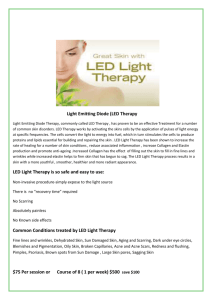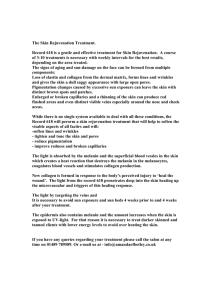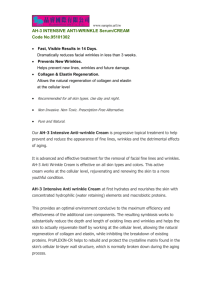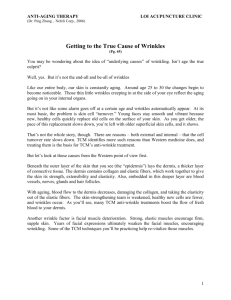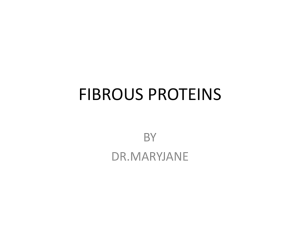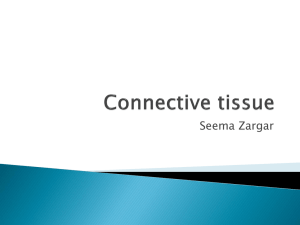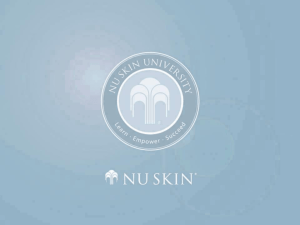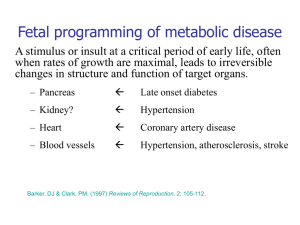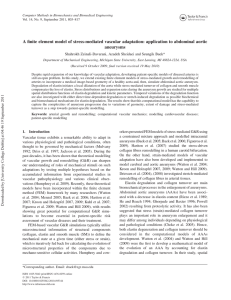Be In Your Skin
advertisement
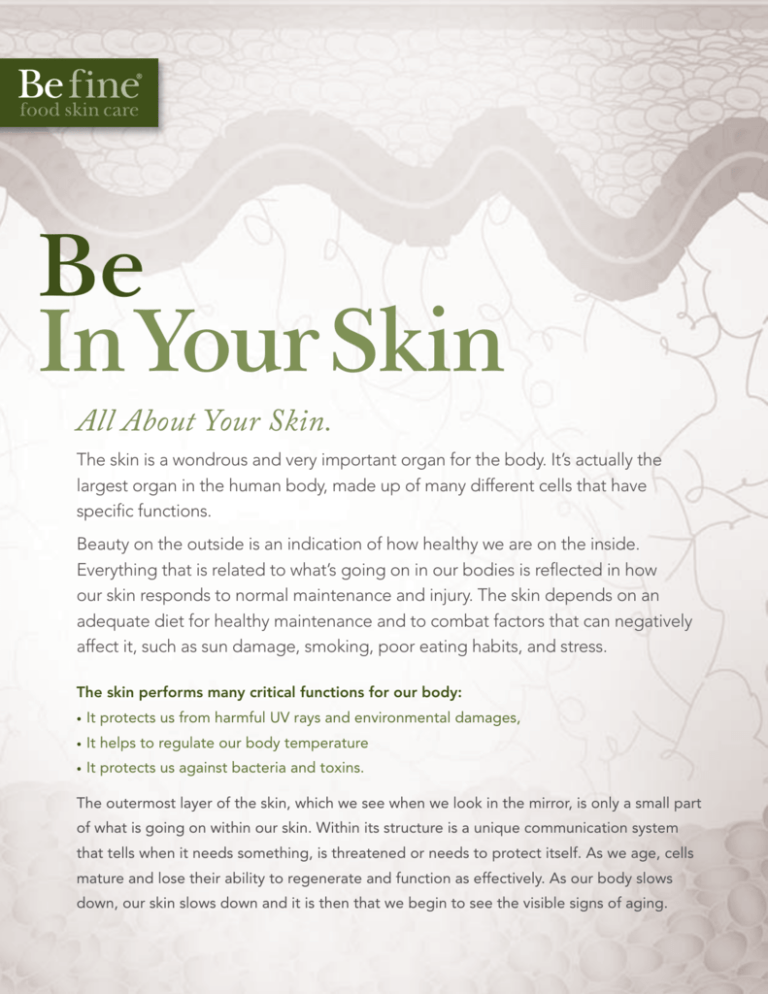
Be InYourSkin All About Your Skin. The skin is a wondrous and very important organ for the body. It’s actually the largest organ in the human body, made up of many different cells that have specific functions. Beauty on the outside is an indication of how healthy we are on the inside. Everything that is related to what’s going on in our bodies is reflected in how our skin responds to normal maintenance and injury. The skin depends on an adequate diet for healthy maintenance and to combat factors that can negatively affect it, such as sun damage, smoking, poor eating habits, and stress. The skin performs many critical functions for our body: • It protects us from harmful UV rays and environmental damages, • It helps to regulate our body temperature • It protects us against bacteria and toxins. The outermost layer of the skin, which we see when we look in the mirror, is only a small part of what is going on within our skin. Within its structure is a unique communication system that tells when it needs something, is threatened or needs to protect itself. As we age, cells mature and lose their ability to regenerate and function as effectively. As our body slows down, our skin slows down and it is then that we begin to see the visible signs of aging. THE SKIN HAS THREE MAJOR SECTIONS: THE EPIDERMIS, DERMIS AND HYPODERMIS. EPIDERMIS The top layer is the epidermis and is made up of cells called keratinocytes, which provide protection for the skin. These cells are constantly regenerated at the base (basal layer) of the epidermis, then dry out and move up through the epidermis. While doing this, they also produce lipids which fill in the spaces between the skin cells, and help enhance the barrier function, especially holding water into the skin. In young, healthy skin, it takes about 14-17 days for a keratinocyte cell to move from the basal layer to the top, where it is sloughed off. The next section, the dermis, is where the structural proteins are located. Here, cells called fibroblasts create proteins called collagen and elastin. Collagen creates a mesh-like structural network in the skin while elastin acts like a spring and provides elasticity for the skin. DERMIS Together, these proteins provide structure for the skin. The hypodermis, made up mostly of fat cells, provides a cushion for the rest of the skin. HYPODERMIS THE SKIN’S PROTEINS: Collagen: It’s the most abundant protein in the skin, making up 75 percent of your skin. This is also your fountain of youth, for it’s responsible for warding off wrinkles and fine lines. Over time, environmental factors and aging diminish your body’s ability to produce collagen. COLLAGEN Elastin: Think elastic. This protein is found with collagen in the dermis. It’s another protein, responsible for giving ELASTIN structure to your skin and organs. As with collagen, elastin is affected by time and the elements. Diminished levels of this protein cause your skin to wrinkle and sag. Keratin: This dominant protein in your skin makes up hair, nails and the surface layer of the skin. Keratin is what forms the rigidity of your skin. SKIN CHARACTERISTICS Texture: Is not just about the look, but the feel of the skin. Texture refers to rough, dry skin and wrinkles as well as blotchy and uneven skin tone. Our skins natural collagen and elastin fibres maintain the texture of the skin. Clarity: Is often used to measure the overall health of the skin. Skin is opaque and sallow when the skin is congested while healthy skin exudes a vibrancy that is promoted by translucent upper skin levels. Pore Size: Pores are tiny openings in our skin that regulate body temperature and maintain the balance of oil to keep our skin from NEW CELL FORMATION 14 - 17 Day Time Lapse drying out. Pores do not open and close, but do appear larger where the oil glands are the most active; for example, our T-zone. Pores also enlarge from years of sun exposure and from the gradual loss of elastin and collagen, causing pores to sag and stretch around the edges as we age. HOW OUR SKIN AGES Skin ages in two ways: 1. Intrinsically: Determined by the genes you inherited from your parents, which means that your genetic composition dictates how your skin ages. Basically, you’re born with it! 2. Extrinsically: Determined by lifestyle and environmental factors. Fortunately, you can control some of the aging process, helping your skin to age as gracefully as possible. SIGNS OF AGING AGING SKIN Our skin begins the aging process while we are young adults, even though we can’t see it. As we get older, the signs of aging become noticeable and our skin changes. Some of the most common signs are: • Loss of Firmness and Elasticity: We see the most significant damage to our collagen and elastin as we age. Instead of nice, healthy fibers, they become thick and coarse. We start to lose firmness in our skin and notice increased sagging, especially in the neck area. • Dry and Dull: As the epidermis thins and becomes dryer, we also see the top layer (stratum corneum) become thick and compacted with dead dry cells, making our skin look rough and lacking radiance. • Fine Lines and wrinkles: Repeated movement can cause wrinkles and lines in active areas. That’s why we see them most often in areas like our eyes, where we squint, around the mouth where we smile or on our forehead known as “worry lines.” DAMAGED CELL CAUSES OF AGING UV Radiation: UVA rays are known as the “aging ray” because they cause damage to the dermis layer of the skin. UVB rays are known as the “burn ray” and damage cells in the epidermis layer, causing serious long-term damage. The sun depletes Vitamin E in the skin, which can lead to a loss of firmness, elasticity and texture, accelerating the aging process. It also triggers excess melanin production, which can produce freckles, age spots (hyperpigmentation) and uneven skin tone. Free Radicals: Free radicals are cells that have become damaged and unstable. These cells have excess energy that is used to attack healthy cells, creating a vicious cycle of damage. Although our skin has built-in defense mechanisms, constant attack can overwhelm and diminish the skin’s ability to defend itself. When they hit the flat part of our skin, some are absorbed and lead to skin disease and damaged DNA. When radicals hit a fine line, they are reflected down into the skin and become pre-wrinkles and eventually deep, full wrinkles. One of the primary functions of the skin is to act as a barrier to keep water in the skin and toxins out. Lipids help the skin retain water moisture and stay hydrated. Free radicals can damage the lipid barrier which creates gaps between cells, allowing water to escape. This leads to drier skin. Lifestyle: Although the majority of how well we age is determined by our genes, there is a lot that we can do to manage free radicals by controlling certain lifestyle factors such as: • Our Diet, the foods we eat and the supplements we take • Our Antioxidant intake • How we manage Stress • Wearing Sunscreen • Getting enough sleep • Whether or not we Smoke • Our Water Intake • Our exercise and physical activity Skin care products play an important role in the health of our skin. Skin has 3 basic requirements for being healthy: To be clean, to be hydrated and to be protected. Skin care products help our skin maintain its balance while helping defend itself from the environment and everyday life.
